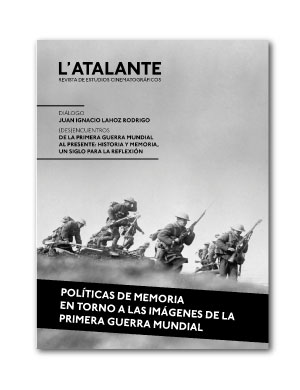Cuaderno
Alegoría, redencionismo y tentación trágica en el cine de Hollywood ante la Gran Guerra (1915-1930)
Publicado 01.01.2016
Palabras clave
- Primera Guerra Mundial,
- tragedia,
- alegoría,
- Griffith,
- Ince
- Corazones del mundo,
- Los cuatro jinetes del Apocalipsis,
- Sin novedad en el frente. ...Más
Cómo citar
Pérez Torio, X. (2016). Alegoría, redencionismo y tentación trágica en el cine de Hollywood ante la Gran Guerra (1915-1930). L’Atalante. Revista De Estudios cinematográficos, (21), 37–45. https://doi.org/10.63700/303
Resumen
El artículo rastrea los usos intuitivos de una estética alegórica -y la tentación trágica que la traspasó- en algunas producciones hollywoodienses nacidas durante la Primera Guerra Mundial y los inmediatos años veinte. La alusión alegórica a la guerra, en clave pacifista y religiosa, se produce ya en los finales de El nacimiento de una nación e Intolerancia, y se manifiesta plenamente en Civilización. La entrada del país en el conflicto revierte en un romanticismo de trama amorosa no exento de connotaciones trágicas (Corazones del mundo), aunque será con el armisticio cuando la alegoría trágica llegará a su extremo en Los cuatro jinetes del apocalipsis. La recuperación del romanticismo de trama amorosa cada vez más evasivo durante los años veinte será replicada, en 1930, con una tragedia realista, sin asomo de transcendentalismo alegórico: Sin novedad en el frente.Descargas
Los datos de descargas todavía no están disponibles.
Citas
<p>Balló, Jordi (2000). <em>Imágenes del silencio</em>. Barcelona: Anagrama. <br />
Bosseno, Christian-Marc (1995). La surimpression. <em>Cahiers du</em> <em>cinéma</em>, <em>hors-série nº 11H</em>: <em>Le siècle du cinema</em>, 56-57.<br />
Chambers II, John Whiteclay (1994). <em>All Quiet on the Western Front</em> (1930): The Antiwar Film and the Image of the First World War. <em>Historical Journal of Film, Radio & Television</em>, 14(4), 377-412.<br />
Del Amo, Antonio (1945). <em>Historia Universal del cine</em>. Madrid: Plus Ultra. <br />
Lenning, Arthur (2011). Hearts of the World, <em>Film History, an International Journal</em>, 23(4), 428-458. <br />
— (2005). The Mother and the Law. <em>Film History, an International Journal</em>, 17, 4, 405-431. <br />
Leutrat, Jean-Louis (1997). El cine bélico. En J. Talens y S. Zunzunegui (coords.), <em>Historia Universal del Cine</em>, <em>vol. IV.</em> <em>América (1915-1928)</em>. Madrid: Cátedra.<br />
Maffessoli, Michel (2003). <em>L’Instant éternel. Le retour du tragique dans les sociétés postmodernes</em>. París: La Table Ronde. <br />
Marzal, José Javier (1998). <em>David Wark Griffith</em>. Madrid: Cátedra. <br />
O’Leary, Liam (1993). <em>Rex Ingram: Master of the Silent Cinema</em>. Londres: British Film Institute. <br />
Ochling, Richard A. (1993). Germans in Hollywood Films, The changing Image, 1914-1939, <em>Film & History</em>, 3(2), 1-10.<br />
Sand, Shlomo (2004). <em>El siglo XX en pantalla. Cien años a través del cine</em>. Barcelona: Crítica. <br />
Simmon, Scott (1993). <em>The Films of D. W. Griffith</em>. Cambridge: Cambrige University Press, 1993. <br />
Smith, Mathew Wilson (2008). American Walkyries: Richard Wagner, D. W. Griffith and the Birth of Classical Cinema. <em>Modernism/Modernity</em>, 15(2), 221-242. <br />
Virilio, Paul (1989). <em>War and Cinema: the Logistics of Perception</em>. Londres: Verso.</p>
Bosseno, Christian-Marc (1995). La surimpression. <em>Cahiers du</em> <em>cinéma</em>, <em>hors-série nº 11H</em>: <em>Le siècle du cinema</em>, 56-57.<br />
Chambers II, John Whiteclay (1994). <em>All Quiet on the Western Front</em> (1930): The Antiwar Film and the Image of the First World War. <em>Historical Journal of Film, Radio & Television</em>, 14(4), 377-412.<br />
Del Amo, Antonio (1945). <em>Historia Universal del cine</em>. Madrid: Plus Ultra. <br />
Lenning, Arthur (2011). Hearts of the World, <em>Film History, an International Journal</em>, 23(4), 428-458. <br />
— (2005). The Mother and the Law. <em>Film History, an International Journal</em>, 17, 4, 405-431. <br />
Leutrat, Jean-Louis (1997). El cine bélico. En J. Talens y S. Zunzunegui (coords.), <em>Historia Universal del Cine</em>, <em>vol. IV.</em> <em>América (1915-1928)</em>. Madrid: Cátedra.<br />
Maffessoli, Michel (2003). <em>L’Instant éternel. Le retour du tragique dans les sociétés postmodernes</em>. París: La Table Ronde. <br />
Marzal, José Javier (1998). <em>David Wark Griffith</em>. Madrid: Cátedra. <br />
O’Leary, Liam (1993). <em>Rex Ingram: Master of the Silent Cinema</em>. Londres: British Film Institute. <br />
Ochling, Richard A. (1993). Germans in Hollywood Films, The changing Image, 1914-1939, <em>Film & History</em>, 3(2), 1-10.<br />
Sand, Shlomo (2004). <em>El siglo XX en pantalla. Cien años a través del cine</em>. Barcelona: Crítica. <br />
Simmon, Scott (1993). <em>The Films of D. W. Griffith</em>. Cambridge: Cambrige University Press, 1993. <br />
Smith, Mathew Wilson (2008). American Walkyries: Richard Wagner, D. W. Griffith and the Birth of Classical Cinema. <em>Modernism/Modernity</em>, 15(2), 221-242. <br />
Virilio, Paul (1989). <em>War and Cinema: the Logistics of Perception</em>. Londres: Verso.</p>

